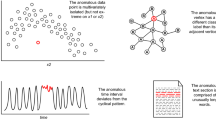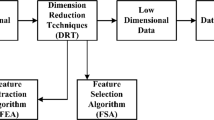Abstract
Set-valued information systems are important generalizations of single-valued information systems. In this paper, three relations are proposed for attribute reduction of set-valued information systems. Then, we convert a large-scale set-valued information system into a smaller relation information system. An incremental algorithm is designed to compress dynamic set-valued information systems. Concretely, we mainly address the compression updating from three aspects: variations of attribute set, immigration and emigration of objects and alterations of attribute values. Finally, several illustrative examples are employed to demonstrate that attribute reduction of dynamic set-valued information systems are simplified significantly by our proposed approaches.
Similar content being viewed by others
References
Banerjee M, Pal SK (1996) Roughness of a fuzzy set. Inf Sci 93(3-4):235–246
Bhatt RB, Gopal M (2005) On the compact computational domain of fuzzy-rough sets. Pattern Recognit Lett 26(11):1632–1640
Biswas R (1994) On rough sets and fuzzy rough sets. Bull Pol Acad Sci Math 42:345–349
Bobillo F, Straccia U (2012) Generalized fuzzy rough description logics. Inf Sci 189:43–62
Capotorti A, Barbanera E (2012) Credit scoring analysis using a fuzzy probabilistic rough set model. Comput Stat Data Anal 56(4):981–994
Chakrabarty K, Biswas R, Nanda S (2000) Fuzziness in rough sets. Fuzzy Sets Syst 110:247–251
Chen HM, Li TR, Qiao SJ, Ruan D (2010) A rough set based dynamic maintenance approach for approximations in coarsening and refining attribute values. Int J Intell Syst 25(10):1005–1026
Chen ZC, Qin KY (2008) Attribute reduction of set-valued information system based on variable precision tolerance realtion. Comput Eng Appl 44: 27–29
Chen ZC, Qin KY (2009) Attribute reduction of set-valued information system based on tolerance relation. Fuzzy Syst Math 23(1):150–154
Dai JH (2013) Rough set approach to incomplete numerical data. Inf Sci. doi:10.1016/j.ins.2013.04.023.
Dai JH, Tian HW (2013) Entropy measures and granularity measures for set-valued information systems. Inf Sci 240:72–82
Dai JH, Tian HW (2013) Fuzzy rough set model for set-valued data. Fuzzy Sets Syst 229:54–68
Dai JH, Wang WT, Tian HW, Liu L (2013) Attribute selection based on a new conditional entropy for incomplete decision systems. Knowl-Based Syst 39:207–213
Dai JH, Xu Q (2012) Approximations and uncertainty measures in incomplete information systems. Inf Sci 198:62–80
Dai JH, Xu Q (2013) Attribute selection based on information gain ratio in fuzzy rough set theory with application to tumor classification. Appl Soft Comput 13(1):211–221
Diker M, Uğur AA (2012) Textures and covering based rough sets. Inf Sci 184(1):44–63
Dubois D, Prade H (1990) Rough fuzzy sets and fuzzy rough sets. Int J General Syst 17:191–209
Feng T, Zhang SP, Mi JS, Feng Q (2011) Reductions of a fuzzy covering decision system. Int J Model Identif Control 13(3):225–233
Gong ZT, Xiao ZY (2010) Communicating between information systems based on including degrees. Int J General Syst 39(2):189–206
Grzymala-Busse JW (2010) Rough set and CART approaches to mining incomplete data. In: 2010 international conference of soft computing and pattern recognition (SoCPaR), Paris, pp 214–219
Grzymala-Busse JW, Sedelow Jr. WA (1988) On rough sets and information system homomorphism. Bull Pol Acad Sci Tech Sci 36(3):233–239
Guan YY, Wang HK (2006) Set-valued information systems. Inf Sci 176(17):2507–2525
Huang B, Li HX, Wei DK (2012) Dominance-based rough set model in intuitionistic fuzzy information systems. Knowl-Based Syst 28: 115–123
Jensen R, Shen Q (2004) Semantics-preserving dimensionality reduction: rough and fuzzy-rough-based approaches. IEEE Trans Knowl Data Eng 16(12):1457–1471
Leung Y, Li DY (2003) Maximal consistent block technique for rule acquisition in incomplete information systems. Inf Sci 153:85–106
Li SY, Li TR, Liu D (2013) Incremental updating approximations in dominance-based rough sets approach under the variation of the attribute set. Knowl Based Syst 40:17–26
Li DY, Ma YC (2000) Invariant characters of information systems under some homomorphisms. Inf Sci 129(1–4):211–220
Li TR, Ruan D, Geert W, Song J, Xu Y (2007) A rough sets based characteristic relation approach for dynamic attribute generalization in data mining. Knowl Based Syst 20(5):485–494
Liu CH, Miao DQ, Zhang N (2012) Graded rough set model based on two universes and its properties. Knowl Based Syst 33:65–72
Liu GL (2010) Rough set theory based on two universal sets and its applications. Knowl Based Syst 23(2):110–115
Liu PH, Chen ZC, Qin KY (2009) Attribute reduction of set-valued information systems based on maximal variable precision tolerance classes. J Sichuan Normal Univ 32(5):576–580
Liu D, Li TR, Liang DC (2013) Incorporating logistic regression to decision-theoretic rough sets for classifications. Int J Approx Reason. doi:10.1016/j.ijar.2013.02.013
Liu D, Li TR, Ruan D (2011) Probabilistic model criteria with decision-theoretic rough sets. Inf Sci 181:3709–3722
Liu D, Li TR, Ruan D, Zhang JB (2011) Incremental learning optimization on knowledge discovery in dynamic business intelligent systems. J Global Optim 51(2):325–344
Liu D, Li TR, Ruan D, Zou WL (2009) An incremental approach for inducing knowledge from dynamic information systems. Fund Inf 94(2):245–260
Morsi NN, Yakout MM (1998) Axiomatics for fuzzy rough sets. Fuzzy Sets Syst 100(1–3):327–342
Meng D, Zhang XH, Qin KY (2011) Soft rough fuzzy sets and soft fuzzy rough sets. Comput Math Appl 62:4635–4645
Miao DQ, Gao C, Zhang N, Zhang ZF (2011) Diverse reduct subspaces based co-training for partially labeled data. Int J Approx Reason 52:1103–1117
Nanda S, Majumdar S (1992) Fuzzy rough sets. Fuzzy Sets Syst 45(2):157–160
Pawlak Z (1982) Rough sets. Int J Comput Inform Sci 11(5):341–356
Qian YH, Dang CY, Liang JY, Tang DW (2009) Set-valued ordered information systems. Inf Sci 179:2809–2832
Qin KY, Pei Z (2005) On the topological properties of fuzzy rough sets. Fuzzy Sets Syst 151:601–613
Qin KY, Yang JL, Pei Z (2008) Generalized rough sets based on reflexive and transitive relations. Inf Sci 178:4138–4141
Skowron A (1990) The rough set theory and evidence theory. Fund Inf 13:245–262
Slezak D, Ziarko W (2005) The investigation of the Bayesian rough set model. Int J Approx Reason 40(1–2):81–91
Wang CZ, Wu CX, Chen DG (2008) A systematic study on attribute reduction with rough sets based on general binary relations. Inf Sci 178(9):2237–2261
Wang SP, Zhu QX, Zhu W, Min F (2012) Matroidal structure of rough sets and its characterization to attribute reduction. Knowl Based Syst 36:155–161
Wang XZ, Tsang E, Zhao SY, Chen DG, Yeung D (2007) Learning fuzzy rules from fuzzy examples based on rough set techniques. Inf Sci 177(20):4493–4514
Wang XZ, Zhai JH, Lu SX (2008) Induction of multiple fuzzy decision trees based on rough set technique. Inf Sci 178(16):3188–3202
Yang T, Li QG (2010) Reduction about approximation spaces of covering generalized rough sets. Int J Approx Reason 51(3):335–345
Yang XB, Song XN, Chen ZH, Yang JY (2012) On multigranulation rough sets in incomplete information system. Int J Mach Learn Cybern 3:223–232
Yang XB, Zhang M, Dou HL (2011) Neighborhood systems-based rough sets in incomplete information system. Knowl Based Syst 24(6):858–867
Yao YY (2003) Probabilistic approaches to rough sets. Expert Syst 20(5):287–297
Yao YY (2010) Three-way decisions with probabilistic rough sets. Inf Sci 180(3):341–353
Yao YY, Zhao Y (2008) Attribute reduction in decision-theoretic rough set models. Inf Sci 178(17):3356–3373
Zakowski W (1983) Approximations in the space (u, π). Demonstratio Math 16:761–769
Zhang JB, Li TR, Ruan D, Liu D (2012) Rough sets based matrix approaches with dynamic attribute variation in set-valued information systems. Int J Approx Reason 53(4):620–635
Zhang JB, Li TR, Ruan D, Liu D (2012) Neighborhood rough sets for dynamic data mining. Int J Intell Syst 27:317-342
Zhu W (2007) Topological approaches to covering rough sets. Inf Sci 177(6):1499–1508
Zhu, P (2011) Covering rough sets based on neighborhoods: An approach without using neighborhoods. Int J Approx Reason 52(3):461–472
Zhu P, Wen QY (2010) Some improved results on communication between information systems. Inf Sci 180(18):3521–3531
Ziarko W (2008) Probabilistic approach to rough sets. Int J Approx Reason 49(2):272–284
Acknowledgments
We would like to thank the anonymous reviewers very much for their professional comments and valuable suggestions. This work is supported by the National Natural Science Foundation of China (No. 11071061,11371130) and the National Basic Research Program of China (No. 2010CB334706, 2011CB311808).
Author information
Authors and Affiliations
Corresponding author
Rights and permissions
About this article
Cite this article
Lang, G., Li, Q. & Yang, T. An incremental approach to attribute reduction of dynamic set-valued information systems. Int. J. Mach. Learn. & Cyber. 5, 775–788 (2014). https://doi.org/10.1007/s13042-013-0225-x
Received:
Accepted:
Published:
Issue Date:
DOI: https://doi.org/10.1007/s13042-013-0225-x




